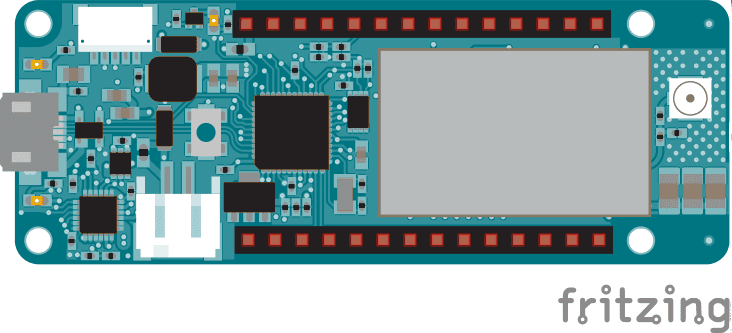GSM Scan Networks
This example prints out the IMEI number of the modem, then checks to see if it's connected to a carrier and prints out its signal strength. It also scans for all nearby networks.
Hardware Required
antenna
SIM card enable for Data
Circuit

Code
First, import the GSM library
#include <GSM.h>
SIM cards may have a PIN number that enables their functionality. Define the PIN for your SIM. If your SIM has no PIN, you can leave it blank :
#define PINNUMBER ""
Initialize instances of the classes you're going to use. You're going to need the GSM, GSMScanner, and GSMModem classes.
GSM gsmAccess;
GSMScanner scannerNetworks;
GSMModem modemTest;Create a variable to hold the IMEI number, and a status messages to send to the serial monitor:
String IMEI = "";
String errortext = "ERROR";In setup, open a serial connection to the computer. After opening the connection, send a message to the Serial Monitor indicating the sketch has started. Call @scannerNetworks.begin()@@ to reset the modem.
void setup(){
Serial.begin(9600);
Serial.println("GSM networks scanner");
scannerNetworks.begin();Create a local variable to track the connection status. You'll use this to keep the sketch from starting until the SIM is connected to the network :
boolean notConnected = true;Connect to the network by calling gsmAccess.begin(). It takes the SIM card's PIN as an argument. By placing this inside a while() loop, you can continually check the status of the connection. When the modem does connect, gsmAccess() will return GSM_READY. Use this as a flag to set the notConnected variable to true or false. Once connected, the remainder of setup will run.
while(notConnected)
{
if(gsmAccess.begin(PINNUMBER)==GSM_READY)
notConnected = false;
else
{
Serial.println("Not connected");
delay(1000);
}
}Get the IMEI of the modem with modemTest.getIMEI() and print it out to the serial monitor.
Serial.print("Modem IMEI: ");
IMEI = modemTest.getIMEI();
IMEI.replace("\n","");
if(IMEI != NULL)
Serial.println(IMEI);In loop(), scan and print out all available networks. This may take some time
Serial.println("Scanning available networks. May take some seconds.");
Serial.println(scannerNetworks.readNetworks());Print out the current connected carrier, and the strength of the signal. Signal strength is on a scale of 0-31, where 0 is the lowest, and 31 is the highest. close the loop().
Serial.print("Current carrier: ");
Serial.println(scannerNetworks.getCurrentCarrier());
Serial.print("Signal Strength: ");
Serial.print(scannerNetworks.getSignalStrength());
Serial.println(" [0-31]");Once your code is uploaded, open the serial monitor to see the status of the connection.
The complete sketch is below.
/*
GSM Scan Networks
This example prints out the IMEI number of the modem,
then checks to see if it's connected to a carrier. If so,
it prints the phone number associated with the card.
Then it scans for nearby networks and prints out their signal strengths.
Circuit:
* MKR GSM 1400 board
* Antenna
* SIM card
Created 8 Mar 2012
by Tom Igoe, implemented by Javier Carazo
Modified 4 Feb 2013
by Scott Fitzgerald
*/
// libraries
#include <MKRGSM.h>
#include "arduino_secrets.h"
// Please enter your sensitive data in the Secret tab or arduino_secrets.h
// PIN Number
const char PINNUMBER[] = SECRET_PINNUMBER;
// initialize the library instance
GSM gsmAccess; // include a 'true' parameter to enable debugging
GSMScanner scannerNetworks;
GSMModem modemTest;
// Save data variables
String IMEI = "";
// serial monitor result messages
String errortext = "ERROR";
void setup() {
// initialize serial communications and wait for port to open:
Serial.begin(9600);
while (!Serial) {
; // wait for serial port to connect. Needed for Leonardo only
}
Serial.println("GSM networks scanner");
scannerNetworks.begin();
// connection state
bool connected = false;
// Start GSM shield
// If your SIM has PIN, pass it as a parameter of begin() in quotes
while (!connected) {
if (gsmAccess.begin(PINNUMBER) == GSM_READY) {
connected = true;
} else {
Serial.println("Not connected");
delay(1000);
}
}
// get modem parameters
// IMEI, modem unique identifier
Serial.print("Modem IMEI: ");
IMEI = modemTest.getIMEI();
IMEI.replace("\n", "");
if (IMEI != NULL) {
Serial.println(IMEI);
}
}
void loop() {
// scan for existing networks, displays a list of networks
Serial.println("Scanning available networks. May take some seconds.");
Serial.println(scannerNetworks.readNetworks());
// currently connected carrier
Serial.print("Current carrier: ");
Serial.println(scannerNetworks.getCurrentCarrier());
// returns strength and ber
// signal strength in 0-31 scale. 31 means power > 51dBm
// BER is the Bit Error Rate. 0-7 scale. 99=not detectable
Serial.print("Signal Strength: ");
Serial.print(scannerNetworks.getSignalStrength());
Serial.println(" [0-31]");
}See Also:
Arduino MKR GSM 1400 - Complete product description.
Getting started with the MKR GSM 1400 - Get everything set up in minutes.
MKRGSM library - Your reference for the GSM Library.
begin()
MKRGSMToolsTestGPRS - Tries to access the internet over GPRS with supplied APN and credentials.
MKRGSMToolsBandManagement - Checks the band currently configured in the modem and allows you to change it.
MKRGSMToolsPinManagement - How to to change or remove the PIN number.
MKRGSMToolsTestModem - Tests to see if the modem of the GSM shield is working correctly.
MKRGSMToolsTestWebServer - A simple web server that replies with nothing, but prints the client's request and the server IP address.
MKRGSMExamplesMakeVoiceCall - How to make a voice call with mic and speaker.
Last revision 2017/11/29 by AG